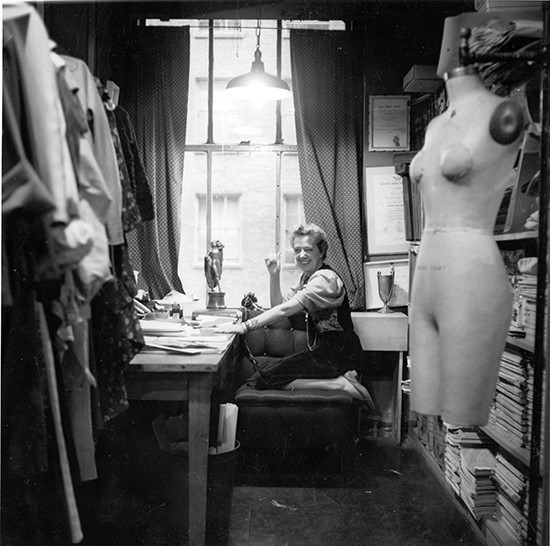Claire McCardell, the mid-century designer who is
one of the founding mothers of
American sportswear, did many things first.
اضافة اعلان
She was the first
designer to put pockets in a dress that was not for housecleaning. The first to
embrace the capsule wardrobe, to use gingham for eveningwear and denim for day
dresses, to popularize the ballet flat, to put her name on her label.
And she was one
of the first to put her philosophy of dress down on paper, offering up what may
still be the best how-to book on navigating a wardrobe that has been written.
Titled “What
Shall I Wear?” and originally published in 1956, the slim volume has now been
reissued in a new edition by Abrams with a foreword by Tory Burch, who has made
it her mission to give McCardell’s name the same status as
Saint Laurent in the
popular imagination.
And though
McCardell’s work is also having something of a moment thanks to the
Metropolitan Museum’s current American fashion extravaganza, which highlights
often overlooked but important American designers (mostly women and designers
of color), the book offers proof of concept in an entirely more accessible,
contemporary kind of a way.
 Claire McCardell in her workroom in the 1950s.
Claire McCardell in her workroom in the 1950s.
Indeed, in an era
that has seen a proliferation of branded glossy coffee-table tomes, not to
mention endless dress advice from influencers on
TikTok and YouTube, it may
prove the essential text for anyone struggling with the basic question of what
to wear to go back to work or school — or for anyone getting up in the morning
and staring morosely into their closet.
That is not just
because much of the advice within is witty, though it is, or because there are
practical suggestions for how to shop and pointed meditations on the importance
of comfortable shoes and investment dressing. But because McCardell focuses on
prioritizing the individual, rather than the industry. Also, she is as good at
aphorisms as
Diana Vreeland, fashion’s most famous deliverer of one-liners,
though McCardell’s have more functional application.
Consider, for
example, a few choice excerpts: “If fashion seems to be saying something that
is not right for you, ignore it.” “If you are smart you will forget labels and
look for fine lines.” Also my personal favorite: “Your job is not so much
tracking down the clothes as tracking down yourself.”
Too true.
McCardell did not
drink the Champagne of fashion; she remixed it. It is this attitude that comes
through in her book — and it was in her clothes. That, as much as anything, was
integral in defining the difference between American style, with its emphasis
on utility and ease, and the more top-down, dictatorial European style. And
that still resonates today.
As McCardell
wrote, “I prefer to think of sports clothes as uninfluenced by Paris — clothes
that wield their own influence.” Clothes that were influencers, in other words,
before influencers. Though influencers themselves could learn something from
the book.
If fashion seems to be saying something that is not right for you, ignore it.
The only time the
text seems arcane is when it gets mired in the gender politics of its era.
These days, “You will be in the spotlight at eight o’clock when you drive your
husband to the train and go on to do the marketing,” can be a little hard to
swallow. Update the words to “You will be in the spotlight at eight o’clock
when you get on the train and go on to work,” however, and they become entirely
relevant.
In a new
afterword to the book, Allison Tolman, vice president for collections and
interpretation for the Maryland Center, posits that the wifey asides were the
work of Edith Heal, McCardell’s ghostwriter, trying to filter the designer’s
palpably independent leanings through a more broadly palatable 1950s lens. This
may be true; Heal’s other work included “The Young Executive’s Wife: You and
Your Husband’s Job.” Either way, it’s not enough to detract from the charm and
currency of McCardell’s book.
Besides, “What
Shall I Wear?” is, it turns out, part of another fashion trend, one in which
designers are becoming vocal book boosters themselves.
Alongside Burch,
peers who have found inspiration in the printed page include Kim Jones of Fendi
and Dior Men’s, who is a compulsive vintage book collector (he has more than 20,000
volumes) and whose first Fendi collection was an ode to the Bloomsbury set. Add
on the list: Joseph Altuzarra, who teamed up with Penguin Classics during the
height of the pandemic and has been handing out famous tomes like “The Odyssey”
and “Moby-Dick” stuffed with fabric swatches as the literary equivalent of mood
boards ever since.
There’s something about a
book’s materiality and authorial style that finds common cause with the
catwalk. If in doubt, simply spend some time with McCardell, whose advice
accessorizes the mind, not just the house — and costs less, these days, than
the price of a tube of haute lipstick.
Read more Books
Jordan News



